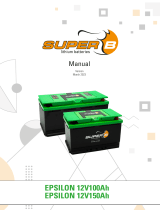
4
1. Charging
Warning! Never overcharge the Li-ion battery, this will permanently damage the Li-ion
battery. Always use a charger which automatically halts the charging process when the
Li-ion battery is full.
Warning! Stop the charging process if the Li-ion battery gets too hot during charging
(>55-60°C).
Warning! Never charge a Li-ion battery with a charging current larger than specied in the
manual as this will damage the Li-ion battery.
Caution! Disconnect the charger from the mains and the Li-ion battery if it is not used for a
long time. Note that the CAN network draws current when active.
Caution! To preserve the lifespan of the Li-ion battery use a suitable charger or a charger
approved by Super B. The use of other chargers, such as lead-acid chargers can shorten the
lifespan of the Li-ion battery. AGM / GEL chargers may be used if the charge voltages and
duration of the different charge states don’t exceed charge specication of the Li-ion battery.
Connect the charger to the Li-ion battery as described in the battery manual.
Charge the Li-ion battery whenever the state of charge drops below 20% to preserve the
lifespan of the Li-ion battery.
If the state of charge drops below 20%, always keep the voltage of the Li-ion battery
above 10 V.
1.1. Charging rate
Super B batteries that are capable to be charge with 1C can be charged from empty (0 % SoC)
to full (100% Soc) in just over an hour. 1C indicates 1 times the capacity of the Li-ion battery so
a 100Ah battery which can be charged with 1C may be charged with 100 A. Displayed in Table 1
are the charge times for the Li-ion battery at different charge currents. Always use the indicated
charge current and end of charge voltage during charging.
Time Charge current (A) Typical end of charge voltage
Maximum 70-80 minutes 1C 14.4V
Endurance
Lifecycle
3 hours + ~20
min C3 14.4V
Table 1. Charging rate Super B lithium batteries
The maximum charge current for Super B lithium batteries is 1C. However for endurance












